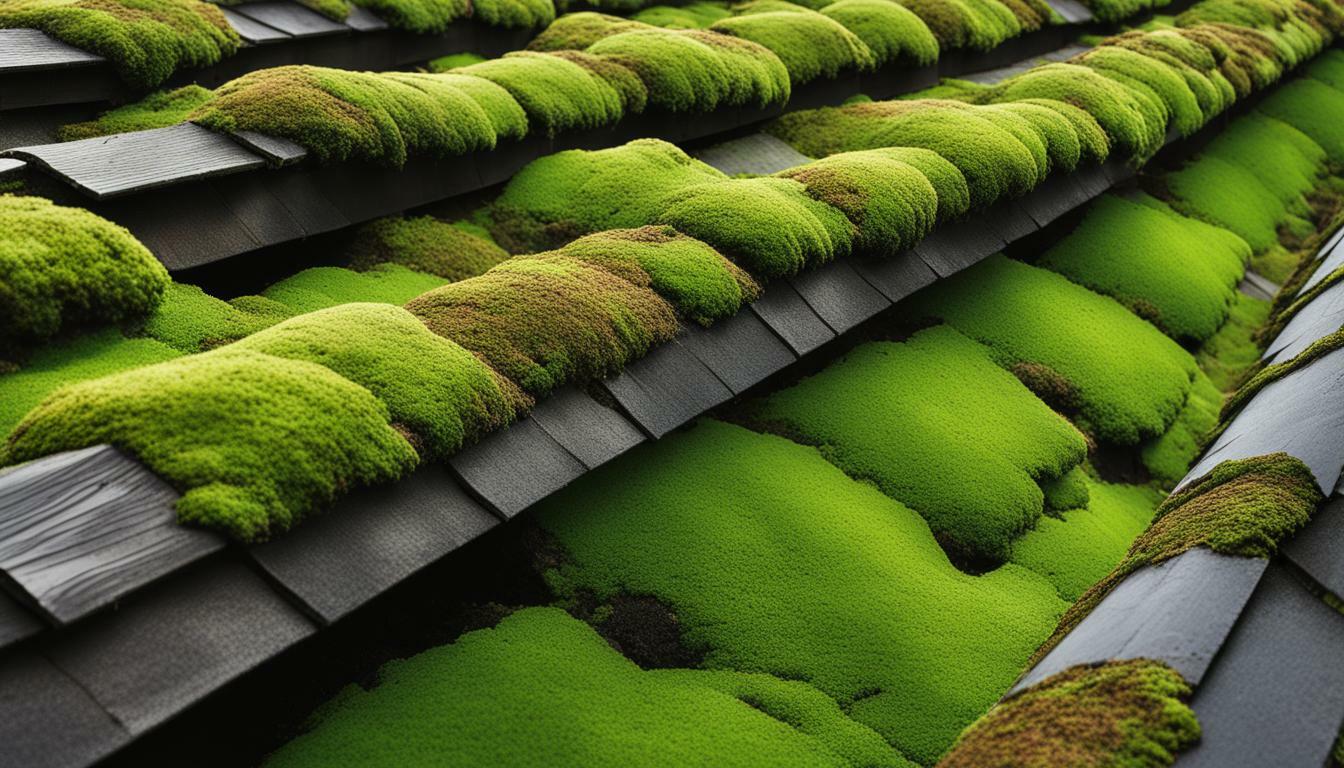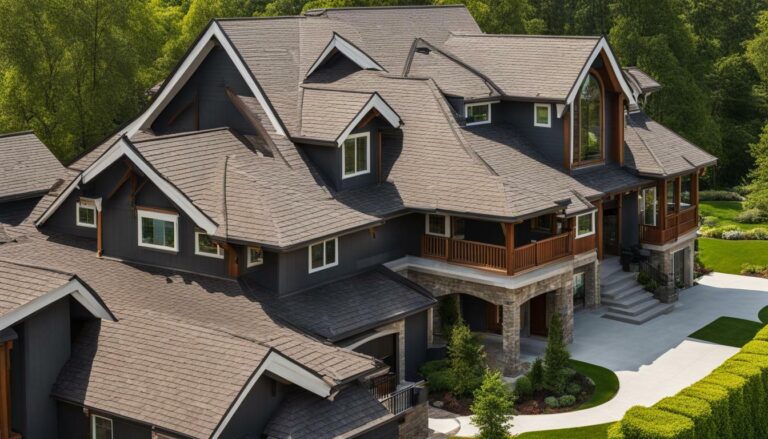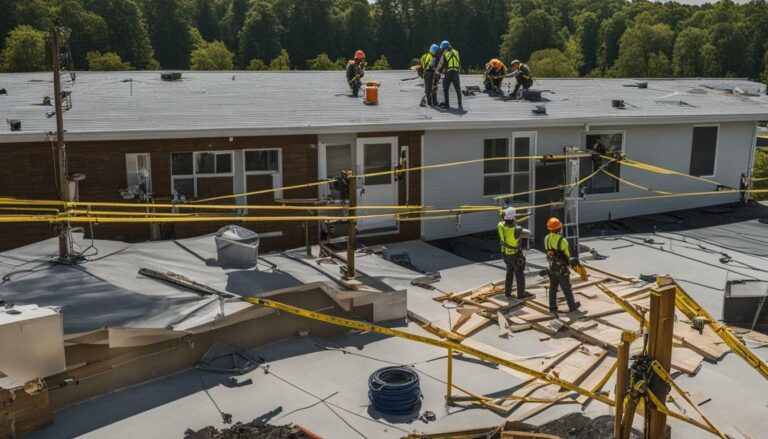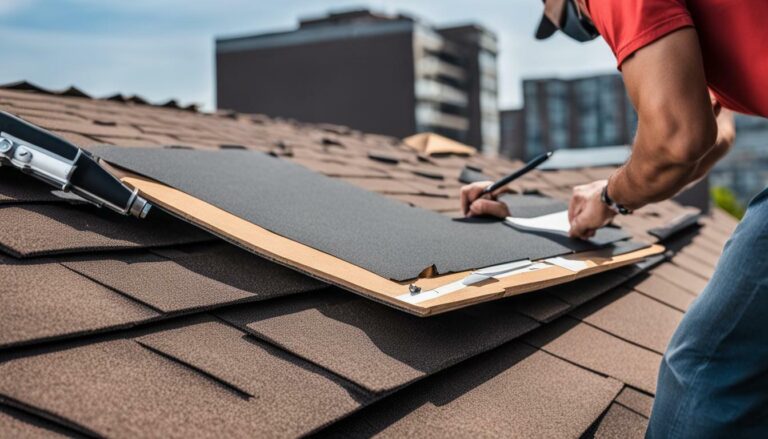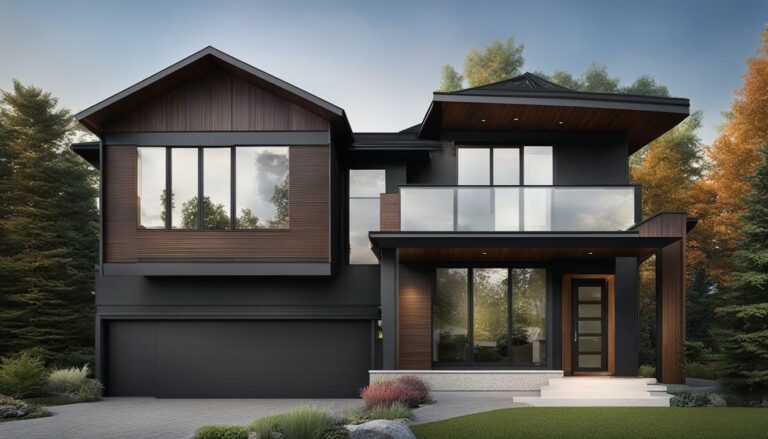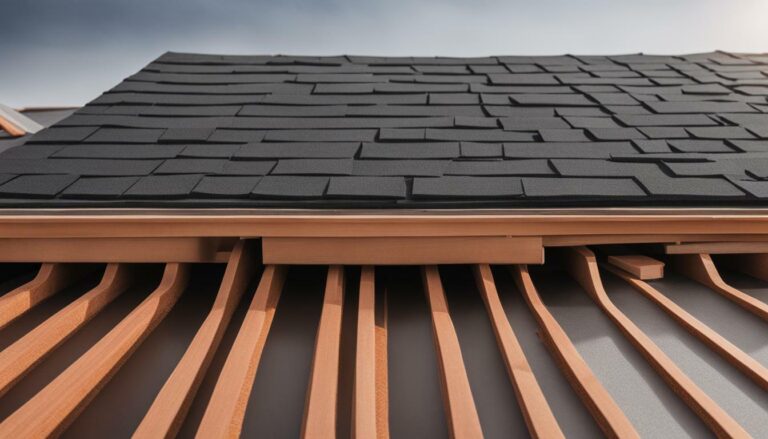Understand the Detrimental Effects of Moss on Roofs
Moss on roofs can have detrimental effects that can reduce the lifespan of the roof and cause structural damage. Moss growth adds weight to the roof and retains water, leading to rot and bacteria. The roots of moss can creep underneath roofing materials, causing holes and leakage. Moss also attracts pests and can be a red flag for potential home buyers. Inspecting a roof under moss can be dangerous due to the slippery surface. Moss grows on roofs due to moisture and organic debris, such as leaves and branches. Trimming back plant growth and keeping gutters free of debris can help prevent moss growth. Leaving moss on the roof can exacerbate water damage and other roofing problems. Moss can grow on any type of roof, including metal and tile roofs. Professional removal of moss is recommended as DIY methods can be ineffective and potentially damage the roof. Preventative measures include applying biocides and moss-resistant coatings, as well as pruning trees and keeping gutters clean. Regular cleaning and maintenance of the roof are necessary to prevent moss growth.
Key Takeaways:
- Moss on roofs can reduce the lifespan of the roof and cause structural damage.
- Weight and water retention from moss can lead to rot and bacterial growth.
- Moss roots can cause holes and leakage in roofing materials.
- Moss attracts pests and can deter potential home buyers.
- Inspecting moss-covered roofs can be dangerous due to the slippery surface.
The Weight and Water Retention Impact of Moss on Roofs
Moss growth on roofs adds weight and retains water, which can lead to roof deterioration and the need for preventive measures. The accumulation of moss on a roof can significantly increase its weight, putting additional stress on the structure. This excess weight can compromise the integrity of the roof and potentially lead to structural damage over time. To prevent roof deterioration due to moss, it is essential to understand the impact of water retention caused by moss growth.
When moss takes hold on a roof, it acts as a sponge, absorbing and retaining water. This prolonged moisture exposure can lead to rotting of the underlying materials and create a breeding ground for bacteria and other microorganisms. The constant presence of moisture can weaken the roof’s structure, causing it to sag or develop leaks. In extreme cases, water infiltration can lead to extensive damage, requiring costly repairs or even a roof replacement.
“A roof covered in moss can retain up to 10 times its weight in water, which can have a detrimental effect on the roof’s longevity and overall condition.”
It is crucial to take preventive measures to mitigate the weight and water retention impact of moss on roofs. Regular roof maintenance, such as cleaning gutters and removing debris, can help prevent the accumulation of organic material that promotes moss growth. Additionally, applying moss-resistant coatings and biocides can inhibit moss growth and prolong the lifespan of the roof. By addressing moss growth and its detrimental effects, homeowners can ensure the long-term durability and functionality of their roofs.
| Preventive Measures for Moss Control: | Regular Roof Cleaning and Maintenance: |
|---|---|
|
|
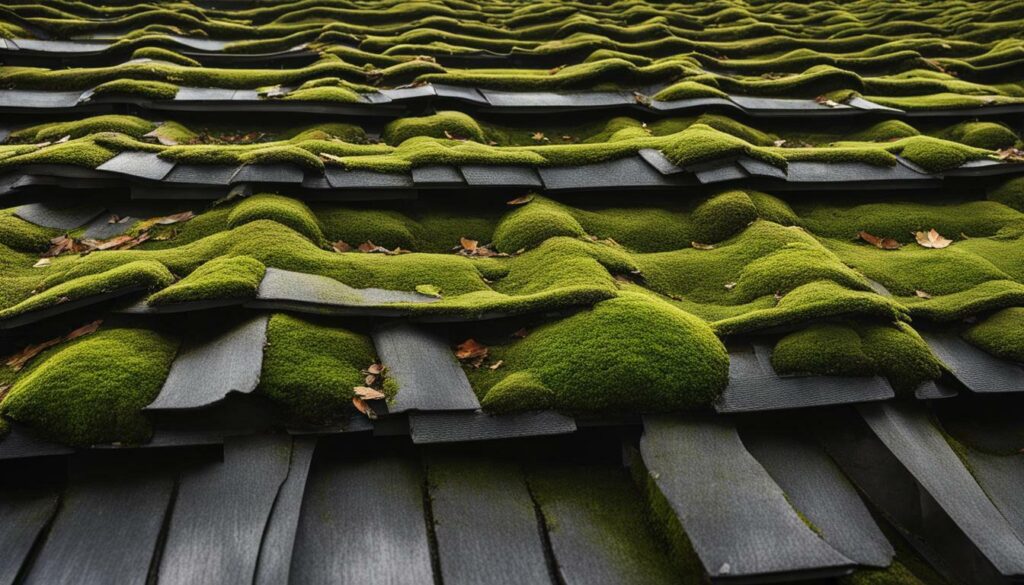
Moss Roots and Their Impact on Roofing Materials
The roots of moss can creep underneath roofing materials, causing holes and leakage that require immediate attention and removal of the moss. When moss takes hold on a roof, its roots extend into the cracks and crevices of roofing materials, compromising their integrity. Over time, this can result in water seepage and damage to the underlying structure of the roof.
To illustrate the potential damage caused by moss roots, consider the image below:
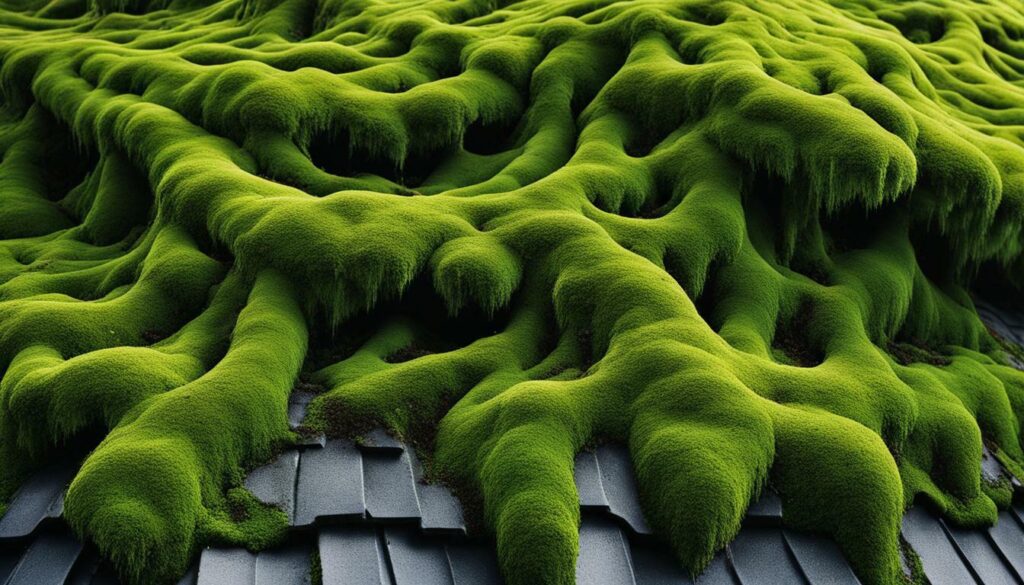
| Damage Caused by Moss Roots | Implications |
|---|---|
| Holes and cracks in roofing materials | Leakage and water damage to the interior of the building |
| Deterioration of shingles and tiles | Reduced lifespan of the roof |
| Compromised structural integrity | Increased risk of collapse |
These consequences highlight the importance of promptly addressing moss growth and removing it from the roof. Ignoring the presence of moss can exacerbate water damage and other roofing problems, leading to more extensive and costly repairs in the future.
Preventing Moss Growth and Protecting Your Roof
To minimize the risk of moss growth on your roof, it is essential to implement preventative measures. Regularly trimming back plant growth around the roof helps to reduce the accumulation of organic debris, such as leaves and branches, which create a conducive environment for moss. Additionally, keeping gutters clean and free of debris prevents water from pooling and providing a moist habitat for moss to thrive.
“Leaving moss on the roof can exacerbate water damage and other roofing problems.”
Furthermore, applying moss-resistant coatings and biocides can help inhibit the growth of moss on the roof. These treatments act as a protective barrier, preventing moss from taking root and causing damage. Professional moss removal services are recommended, as they possess the expertise and equipment to effectively remove moss without causing harm to the roof.
In conclusion, moss roots can have a detrimental impact on roofing materials, causing holes, leakage, and structural damage. It is crucial to promptly address moss growth and implement preventative measures to protect the integrity of your roof. Regular cleaning and maintenance, along with professional moss removal, will ensure a longer lifespan for your roof and help prevent costly repairs down the line.
Pests and Potential Home Buyer Considerations
Moss on roofs not only poses a threat to the structure itself but can also attract pests and deter potential home buyers due to its unappealing appearance. The presence of moss can create an impression of neglect and raise concerns about the overall condition of the property. As a result, it may be more challenging to sell a home with a moss-covered roof.
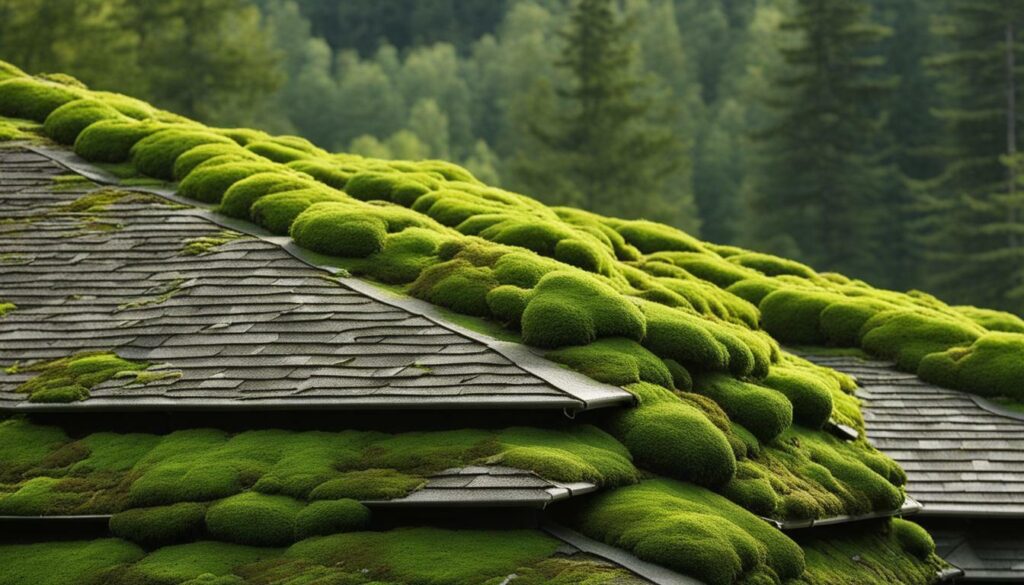
Furthermore, moss provides a favorable environment for pests to thrive. Insects, rodents, and other critters are often attracted to the moisture and organic matter that moss retains. This can lead to infestations in the roof and potentially infiltrate the interior of the home, causing further damage and health risks.
It is crucial to address any moss growth on your roof promptly. Not only will this help preserve the structural integrity of your home, but it will also enhance its curb appeal, making it more attractive to potential buyers. Taking proactive measures to prevent and remove moss is essential for maintaining a healthy and visually appealing roof.
To ensure a moss-free roof, consider consulting with professionals who specialize in moss removal and prevention. They have the knowledge and tools to safely and effectively eliminate moss without causing any damage to the roof or surrounding areas. Investing in professional moss treatment can save you time, effort, and potential repair costs in the long run.
Safety Hazards of Inspecting Moss-Covered Roofs
Inspecting a roof covered in moss can be hazardous due to the slippery surface it creates, making it important to take necessary safety measures. The presence of moss on a roof increases the risk of accidents and injuries, especially when attempting to walk or climb on the surface. This is particularly true when the roof is wet or damp, as moisture further enhances the slippery nature of moss. To ensure a safe inspection, it is recommended to wear appropriate footwear with non-slip soles and to use safety equipment such as harnesses and ropes.
In addition to the slippery surface, inspecting moss-covered roofs poses the risk of falling debris. As moss grows and accumulates, it can loosen roofing materials and dislodge debris such as twigs, leaves, or even small rocks. These materials can fall from the roof, potentially causing injury to those below. It is essential to exercise caution and wear protective gear, such as hard hats, while conducting inspections to minimize the risk of being struck by falling debris.
To illustrate the dangers of inspecting moss-covered roofs, consider the following quote from a roofing expert:
“Inspecting roofs covered in moss can be treacherous. The slippery surface makes it challenging to maintain balance and stability. Without proper precautions, individuals run the risk of serious injury from slipping or falling debris. It is crucial to prioritize safety and take the necessary measures to protect oneself during inspections.” – John Smith, Roofing Specialist
Safety Precautions for Moss-Covered Roof Inspections
When inspecting moss-covered roofs, it is vital to follow these safety precautions:
- Wear appropriate footwear with non-slip soles for better traction.
- Use safety equipment, such as harnesses and ropes, to prevent falls.
- Wear protective gear, including hard hats, to shield against falling debris.
- Exercise caution and maintain balance while walking on the slippery roof surface.
- Avoid inspecting the roof during wet or rainy conditions to reduce slipperiness.
By adhering to these safety measures, you can mitigate the risks associated with inspecting moss-covered roofs and ensure a safer evaluation process.

Causes of Moss Growth on Roofs
Moss growth on roofs is primarily caused by moisture and the accumulation of organic debris, making preventive measures crucial to maintaining a moss-free roof. When a roof is exposed to constant moisture, whether from rain or high humidity, it creates an ideal environment for moss to thrive. Additionally, the accumulation of organic debris, such as leaves, branches, and dirt, provides nutrients that further support moss growth.
To prevent moss from taking hold on your roof, it is important to address the underlying causes. Regular maintenance, including trimming back overhanging tree branches and ensuring gutters are clean and free from debris, can help minimize moisture buildup and organic matter accumulation. By keeping the roof clean and clear of these factors, you can significantly reduce the chances of moss growth.
Preventative Measures
Implementing preventative measures is key to maintaining a moss-free roof. There are several effective methods that can be employed:
- Biocides: Applying biocides, such as zinc or copper-based treatments, can inhibit moss growth on roofs. These treatments kill or suppress moss, preventing it from taking hold and spreading.
- Moss-resistant coatings: Coating the roof with a moss-resistant product provides an extra layer of protection against moss growth. These coatings create a surface that makes it difficult for moss spores to attach and take root.
- Tree pruning: Trim back any branches or foliage that may be overhanging the roof. This helps to reduce shade and allows the roof to dry faster after rainfall, minimizing the moisture that moss thrives on.
- Gutter maintenance: Regularly clean and clear your gutters to ensure proper drainage. Clogged gutters can trap water, providing a breeding ground for moss and other moisture-related issues.
By implementing these preventative measures and regularly maintaining your roof, you can effectively reduce the risk of moss growth and extend the lifespan of your roof. Remember, prevention is key when it comes to moss on roofs, so it’s important to take action before the problem arises.

Moss Growth on Different Roof Types
Moss can grow on any type of roof, from traditional shingle roofs to modern metal and tile roofs, necessitating consistent efforts to prevent its growth. While some may assume that certain roof types are immune to moss infestation, the reality is that moss can take hold on any surface where moisture and organic debris are present.
Metal roofs, with their smooth surfaces, may seem less susceptible to moss growth, but they can still be affected. Moss can find its way between the seams and joints of metal roofing panels, taking hold and causing damage over time. Similarly, tile roofs, with their textured surfaces, offer ample nooks and crannies for moss to attach and flourish.

Even composite roofs, commonly found on residential homes, are not immune to moss growth. The porous nature of composite materials provides an ideal environment for moss to take root and thrive. Regardless of the type of roof, moss growth can lead to a host of problems, including structural damage, increased water retention, and decreased longevity.
It is essential for homeowners to recognize that moss growth is not limited to a specific roof type. Regular maintenance, including cleaning and moss prevention measures, should be implemented across all roof types to safeguard against the harmful effects of moss.
Professional Moss Removal and Prevention
Professional moss removal and prevention methods are recommended to ensure safe and effective treatment without causing any damage to the roof. Moss on roofs can have detrimental effects that can reduce the lifespan of the roof and cause structural damage. Moss growth adds weight to the roof and retains water, leading to rot and bacteria. The roots of moss can creep underneath roofing materials, causing holes and leakage. Moss also attracts pests and can be a red flag for potential home buyers. Inspecting a roof under moss can be dangerous due to the slippery surface.
To address moss growth on your roof, it is advisable to seek professional assistance. Professionals are equipped with the knowledge and tools to effectively remove moss and treat the underlying issues. They will ensure that the removal process is conducted safely, without causing any damage to the roof or surrounding areas. By utilizing professional services, you can be confident in the thoroughness of the treatment and the long-term effectiveness of the preventative measures implemented.
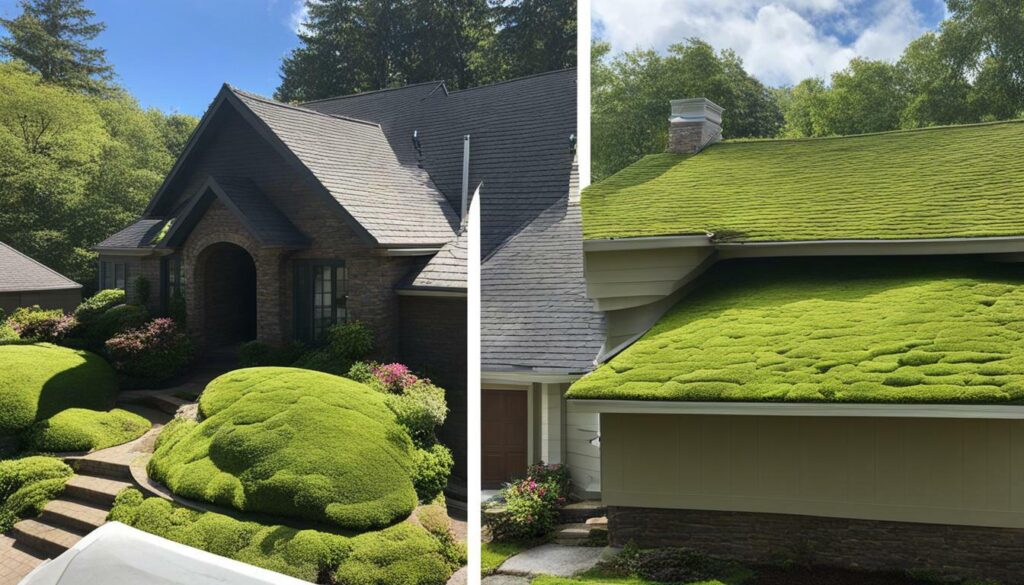
Preventative measures are just as important as moss removal. Professionals can provide expert advice on preventative strategies that will help minimize future moss growth on your roof. This may include the application of biocides and moss-resistant coatings, which create an inhospitable environment for moss to thrive. Additionally, they may recommend tree pruning to reduce shade and organic debris that can contribute to moss growth. Regular gutter maintenance is also crucial, as clogged gutters can lead to excessive moisture buildup, facilitating moss growth.
Regular cleaning and maintenance of the roof are necessary to prevent moss growth. By keeping your roof free of debris, such as leaves and branches, you can help reduce the conditions favorable for moss to take hold. Trimming back plant growth that casts shade on the roof will also help inhibit moss growth. Taking proactive steps to address moss growth will not only protect the longevity of your roof but also maintain its overall aesthetic appeal.
Moss Removal and Prevention Checklist:
- Hire professional moss removal and prevention services
- Ensure safe treatment without causing damage to the roof
- Address weight and water retention caused by moss
- Prevent root intrusion and potential leakage
- Deter pests and avoid concerns for potential home buyers
- Exercise caution when inspecting moss-covered roofs due to slippery surfaces
- Eliminate moisture and organic debris that promote moss growth
- Apply biocides and moss-resistant coatings
- Prune trees and maintain clean gutters
- Regularly clean and maintain the roof to prevent moss growth
By following these steps and seeking professional assistance, you can effectively remove moss from your roof and implement preventative measures to minimize future growth. Protecting your roof from the detrimental effects of moss will prolong its lifespan and save you from costly repairs down the line.
Preventative Measures for Moss Control
To effectively control moss growth on roofs, it is essential to implement preventative measures such as applying biocides, using moss-resistant coatings, pruning trees, and maintaining clean gutters. These measures not only help prevent moss from taking hold but also protect the integrity of your roof and prolong its lifespan.
One effective method of moss control is the application of biocides. Biocides are chemical substances that inhibit the growth and spread of moss. They can be applied directly to the roof surface to kill existing moss and prevent new growth. It is important to carefully follow the manufacturer’s instructions when using biocides to ensure safe and effective application.
Another preventative measure is the use of moss-resistant coatings. These specialized coatings create an inhospitable environment for moss by incorporating ingredients that inhibit its growth. When applied to the roof surface, these coatings act as a barrier, preventing moss spores from taking root and thriving. Regular maintenance, including reapplication of the coating as needed, helps ensure long-lasting moss resistance.
In addition to chemical treatments, proper tree pruning and gutter maintenance are crucial for preventing moss growth on roofs. Overhanging branches and excessive plant growth nearby can provide additional shade and moisture, creating favorable conditions for moss to develop. Trimming back plants and branches away from the roof helps minimize these conditions. Clean gutters are also essential, as clogged gutters can lead to water overflow and provide a fertile breeding ground for moss. Keeping gutters free from debris allows water to flow freely, reducing the risk of moss growth.
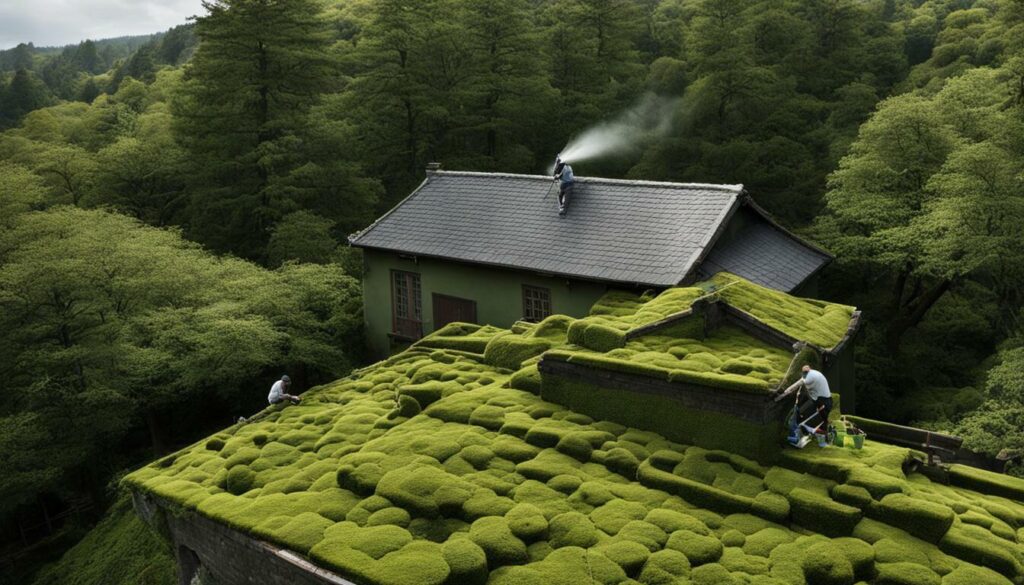
| Preventative Measures | Description |
|---|---|
| Apply Biocides | Chemical substances that inhibit the growth and spread of moss. Used to kill existing moss and prevent new growth. |
| Use Moss-Resistant Coatings | Specialized coatings that create an inhospitable environment for moss. Act as a barrier to prevent moss spores from thriving. |
| Prune Trees | Proper tree pruning helps minimize shade and moisture on the roof, reducing conditions favorable for moss growth. |
| Maintain Clean Gutters | Clean gutters prevent water overflow and provide a breeding ground for moss. Regular maintenance ensures proper water flow. |
“Implementing these preventative measures will not only help control moss growth on your roof, but also protect its structural integrity and extend its lifespan. By applying biocides, using moss-resistant coatings, pruning trees, and keeping gutters clean, you can ensure a moss-free roof that will stand the test of time.”
Regular Roof Cleaning and Maintenance
Regular cleaning and maintenance of the roof are crucial in preventing moss growth and related problems, ensuring the longevity and functionality of the roof. Moss on roofs can have detrimental effects that can reduce the lifespan of the roof and cause structural damage. Moss growth adds weight to the roof and retains water, leading to rot and bacterial growth. The roots of moss can creep underneath roofing materials, causing holes and leakage. Moss also attracts pests and can be a red flag for potential home buyers.
| Preventative Measures for Moss Control | Professional Moss Removal and Prevention |
|---|---|
|
|
Inspecting a roof covered in moss can be dangerous due to the slippery surface created by the moss growth. It is important to exercise caution and take proper safety precautions when inspecting or attempting any maintenance on a moss-covered roof.
Moss grows on roofs due to moisture and the presence of organic debris, such as leaves and branches. Trimming back plant growth and ensuring that gutters are regularly cleaned and free of debris can help prevent moss growth. Leaving moss on the roof can exacerbate water damage and other roofing problems.
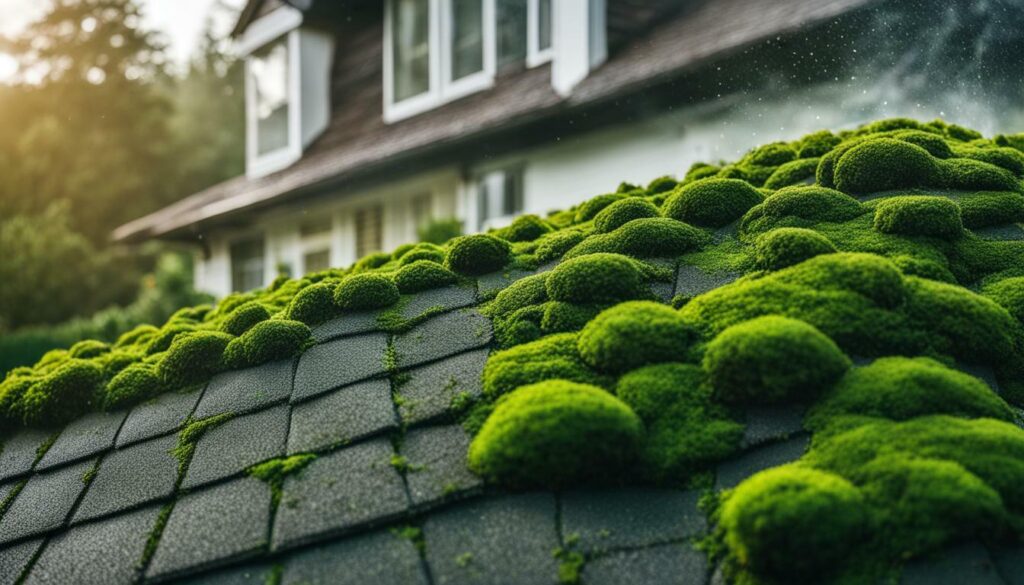
Moss Growth on Different Roof Types
Moss can grow on any type of roof, including metal and tile roofs. No roof type is immune to moss growth. Therefore, it is essential to implement regular cleaning and maintenance practices regardless of the roof’s material. By doing so, you can mitigate the risk of moss-related issues and ensure the optimal condition of your roof.
Maintaining a clean and moss-free roof not only enhances the aesthetic appeal of your home but also extends the lifespan of the roof. Regular inspections, cleaning, and maintenance by professionals can help identify and address any potential moss growth early on, saving you from costly repairs and potential structural damage in the long run.
Conclusion
In conclusion, moss on roofs can have detrimental effects on their lifespan and structural integrity, making it essential to take preventive measures and address moss growth promptly. Moss growth adds weight to the roof and retains water, which can lead to rot and bacteria, causing damage over time. The roots of moss can creep underneath roofing materials, resulting in holes and leakage. Additionally, moss attracts pests and can be a red flag for potential home buyers.
Inspecting a roof covered in moss can be hazardous due to the slippery surface it creates. Therefore, it is crucial to prioritize safety and take proper precautions when dealing with moss-covered roofs.
Moss growth on roofs is primarily caused by moisture and the presence of organic debris, such as leaves and branches. Preventative measures such as trimming back plant growth and keeping gutters free of debris can help minimize moss growth. Leaving moss untreated on the roof can exacerbate water damage and other roofing issues.
Moss can grow on any type of roof, including metal and tile roofs. To effectively remove moss, it is recommended to seek professional assistance, as DIY methods can be ineffective and potentially cause damage to the roof. Implementing preventative measures such as applying biocides and moss-resistant coatings, pruning trees, and regularly cleaning and maintaining the roof are essential for preventing moss growth and preserving the longevity of the roof.
FAQ
Q: What are the detrimental effects of moss on roofs?
A: Moss on roofs can reduce the lifespan of the roof, cause structural damage, and lead to rot and bacterial growth. It can also attract pests and be a red flag for potential home buyers.
Q: How does moss add weight to the roof and retain water?
A: Moss adds weight to the roof and retains water, leading to rot and bacterial growth. The roots of moss can creep underneath roofing materials, causing holes and leakage.
Q: Why is moss growth on roofs a concern for potential home buyers?
A: Moss growth on roofs can be a red flag for potential home buyers as it indicates potential damage and poor maintenance of the property.
Q: Is it dangerous to inspect a roof covered in moss?
A: Yes, inspecting a roof covered in moss can be dangerous due to the slippery surface created by the moss growth.
Q: What causes moss to grow on roofs?
A: Moss grows on roofs due to moisture and the presence of organic debris, such as leaves and branches.
Q: Can moss grow on any type of roof?
A: Yes, moss can grow on any type of roof, including metal and tile roofs.
Q: What are the recommended methods for moss removal and prevention?
A: Professional moss removal is recommended to effectively treat moss growth on roofs. DIY methods can be ineffective and potentially damage the roof. Preventative measures include applying biocides and moss-resistant coatings, as well as pruning trees and keeping gutters clean.
Q: How can moss growth on roofs be prevented?
A: To prevent moss growth on roofs, it is important to regularly clean and maintain the roof, remove organic debris, and take preventative measures such as applying biocides and moss-resistant coatings, and pruning trees.
Q: Why is regular roof cleaning and maintenance necessary?
A: Regular roof cleaning and maintenance are necessary to prevent moss growth and other roofing problems. It helps to keep the roof in optimal condition and minimize the risk of moss-related issues.
